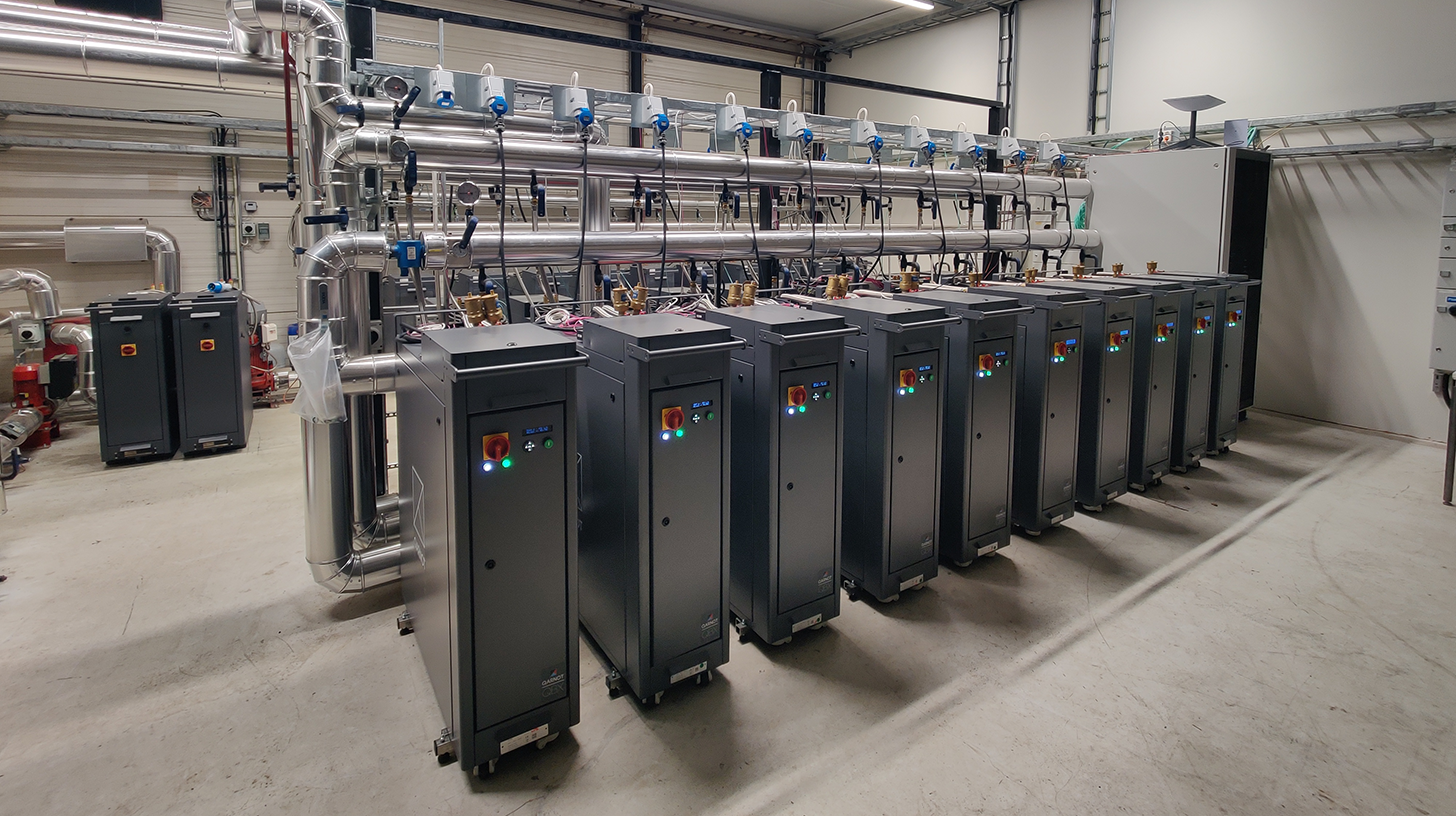
Heating instead of cooling: This ingenious concept is now revolutionizing data centers – Image: Qarnot
PC waste heat heats swimming pools: The simple idea that makes cloud computing 50% cheaper
Qarnot Computing: The revolution of high-performance computing through sustainability and sovereignty
In a world increasingly driven by data and complex simulations, the demand for computing power has grown exponentially. Industries such as aerospace, automotive, energy, and defense rely on high-performance computing (HPC) to drive innovation, develop products, and understand complex phenomena. But this insatiable hunger for computing power has a downside: traditional data centers have become enormous energy consumers, with cooling accounting for a significant portion of their environmental footprint. It is precisely at this critical juncture that the French company Qarnot is addressing, presenting a radically new vision for the future of cloud computing—one that combines performance, cost-effectiveness, sustainability, and digital sovereignty in a unique model.
Who is Qarnot? A European pioneer redefining the cloud
Qarnot is more than just another cloud service provider. The company has set itself the goal of reshaping the European HPC landscape from the ground up. At its core, Qarnot offers an intuitive HPC-as-a-Service (HPCaaS) platform specifically tailored to the needs of engineers and research teams. The underlying idea is to eliminate the enormous complexity traditionally associated with managing HPC infrastructures. Instead of having to deal with configuring servers, maintaining clusters, and managing IT infrastructure, users can fully focus on their core work: research, development, and simulation.
Qarnot's mission is to provide engineers in strategically important sectors with the tools they need to innovate faster and more effectively. Whether simulating the aerodynamics of a new aircraft, conducting virtual crash tests for an automobile, analyzing seismic data in the energy sector, or modeling fluid dynamics for ship designs, Qarnot's platform provides seamless access to thousands of state-of-the-art CPU and GPU cores. Users can effortlessly run multiple compute clusters in parallel and dynamically scale their workloads to achieve precise and reproducible results, drastically shortening the innovation cycle. Accessibility is ensured through a variety of interfaces, including a user-friendly web interface, SDKs for programmatic integration, a powerful API, and a command line interface (CLI) for advanced users. This enables smooth integration into existing workflows and connectivity to industry-leading simulation software such as Ansys Fluent, Abaqus, or OpenFOAM.
The heart of the innovation: Sustainability through intelligent heat recovery
What fundamentally distinguishes Qarnot from traditional cloud providers and hyperscalers is its proprietary infrastructure and revolutionary heat recovery technology. Conventional data centers are massive, centralized buildings that consume immense amounts of energy—not only for running the servers themselves, but especially for cooling them. Up to 40 percent of a data center's total energy consumption can be spent on air conditioning alone to prevent processors from overheating. This waste heat is typically released unused into the atmosphere, representing a massive energy waste.
Qarnot reverses this principle. Instead of viewing waste heat as a waste product, it is treated as a valuable resource. The company has developed a decentralized model in which its HPC clusters are not housed in large, isolated data centers, but directly where heat is needed. These locations can be district heating networks, public swimming pools, industrial facilities, or even residential buildings. The core of this technology is the "digital boiler," also called QBx. Each of these clusters is equipped with a patented direct water cooling system. Instead of cooling the servers with noisy and energy-intensive fans, water circulates through a closed-loop system of copper pipes connected directly to the processors.
Special passive heat exchangers transfer up to 95 percent of the waste heat generated by the servers to the water. This water is heated to temperatures of up to 65 degrees Celsius and can then be fed directly into the heating system of the respective site. It thus supplies buildings with heat or swimming pools with hot water all year round. Because the system operates in a closed loop, no water is wasted, and no additional energy is required to cool the servers. This ingenious approach not only drastically reduces Qarnot's operating costs but also reduces the carbon footprint of the simulations conducted by up to 80 percent compared to conventional data centers. It is a prime example of a circular economy, in which a waste product from one process becomes a valuable raw material for another.
Digital sovereignty: A European bulwark in the data world
In a time of increasing geopolitical tensions and data privacy concerns, the concept of digital sovereignty has become crucial for many companies and governments. Maintaining control over one's own data and underlying IT infrastructure is particularly essential for sensitive industries such as defense, aerospace, and critical infrastructure. Dependence on non-European cloud providers carries risks ranging from unexpected price increases and supply chain disruptions to subjection to foreign legislation such as the US CLOUD Act, which allows US authorities to access data even outside the US.
Qarnot has built its entire strategy on the principle of complete control over the entire value chain to ensure true European sovereignty. This model is based on five pillars:
Complete control of the infrastructure
Unlike many providers that lease computing power from large hyperscalers, Qarnot designs, builds, and operates its own hardware and infrastructure. This gives the company full control over performance, security, and costs.
Decentralized European locations
All Qarnot servers are operated exclusively within the European Union. This not only ensures compliance with strict European data protection standards such as the GDPR, but also increases reliability through geographical distribution.
Hardware independence through OCP
Qarnot relies on the Open Compute Project (OCP) standard. OCP is an initiative that promotes open and standardized hardware designs for data centers. This avoids dependence on individual hardware manufacturers (vendor lock-in) and enables a more flexible, cost-efficient, and adaptable infrastructure.
An open-source software stack
Most of the software used by Qarnot is based on open source technologies. Critical components are also developed in-house. This increases transparency, security, and independence from proprietary software licenses.
Strict compliance with European standards
Qarnot is committed to adhering to the highest European security and legal standards, which is critical for customers in regulated and sensitive industries.
This comprehensive autonomy protects Qarnot and its customers from external shocks and guarantees long-term price stability and operational resilience. It makes Qarnot a strategic partner for all organizations for whom data sovereignty and security of supply are top priorities.
Performance and cost efficiency: When sustainability becomes a competitive advantage
Qarnot's business model impressively demonstrates that ecological sustainability and economic success don't have to be mutually exclusive. In fact, sustainability is the key to the platform's exceptional cost-effectiveness. By eliminating the enormous costs of cooling and additionally monetizing waste heat by selling it to heat partners, Qarnot can offer its HPC services at prices up to 50 percent lower than those of traditional cloud providers. This democratizes access to high-performance computing, making it affordable even for small and medium-sized enterprises or research institutions that previously couldn't afford expensive computing clusters.
At the same time, no compromises are made on performance. The platform offers access to the latest generations of processors and accelerators from leading manufacturers such as AMD and Intel. The distributed architecture enables high scalability, allowing users to access thousands of cores on demand to run even the most demanding simulations in record time. The elimination of IT overhead leads to further indirect savings. Engineers and scientists can save up to 50 percent of the time they would otherwise spend managing infrastructure. This saved time can be channeled directly into productive research and development work, further increasing the speed of innovation and the company's competitiveness.
An intuitive platform built for engineers
Technological progress is only truly valuable when it is simple and accessible for the people who are meant to use it. Qarnot has taken this principle to heart when developing its platform. The user interface and the entire user experience are designed to abstract the complexity of high-performance computing. An engineer doesn't need to be a system administration expert to harness the full power of the Qarnot infrastructure.
The typical workflow is incredibly simple: A user uploads their simulation model, selects the required computing resources—such as the number of CPU or GPU cores and the amount of RAM—using an intuitive interface, configures the desired software environment, and starts the computing job with just a few clicks. The platform automatically takes care of cluster provisioning, task distribution, and resource management in the background. Job progress can be monitored in real time, and the results are available for download upon completion. This simplicity and high degree of automation significantly lower the barrier to entry for HPC and enable teams of all sizes to utilize cutting-edge simulation technologies.
The future of computing is green, sovereign and efficient
Qarnot is at the forefront of a movement redefining the paradigm of computing. At a time when climate change and digital independence are among the greatest challenges facing our society, the company offers a compelling response. It demonstrates that unstoppable technological progress doesn't necessarily have to come at the expense of the environment. Instead, technology, when intelligently designed, can be part of the solution.
Qarnot's model is more than just a clever business model; it's a holistic approach that combines technological excellence with ecological responsibility and strategic autonomy. By transforming waste heat from a problem into a resource, it creates a win-win situation for the digital industry and the local community. By relying on a fully European, sovereign infrastructure, it strengthens the continent's technological independence. And by making high-performance computing accessible and affordable, it empowers the innovators of today and tomorrow to solve the complex problems of our time. The future of high-performance computing will not take place in vast, energy-hungry halls, but rather decentralized, integrated, and in harmony with our environment—and Qarnot is leading the way.

